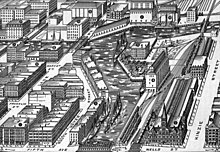
The Willis Tower, originally and still commonly referred to as the Sears Tower, is a 110-story, 1,451-foot (442.3 m) skyscraper in the Loop community area of Chicago in Illinois, United States. Designed by architect Bruce Graham and engineer Fazlur Rahman Khan of Skidmore, Owings & Merrill (SOM), it opened in 1973 as the world's tallest building, a title that it held for nearly 25 years. It is the third-tallest building in the Western Hemisphere, as well as the 23rd-tallest in the world. Each year, more than 1.7 million people visit the Skydeck observation deck, the highest in the United States, making it one of Chicago's most popular tourist destinations.

Fort Dearborn was a United States fort, first built in 1803 beside the Chicago River, in what is now Chicago, Illinois. It was constructed by U.S. troops under Captain John Whistler and named in honor of Henry Dearborn, then United States Secretary of War. The original fort was destroyed following the Battle of Fort Dearborn during the War of 1812, and a replacement Fort Dearborn was constructed on the same site in 1816 and decommissioned by 1837.

The Chicago River is a system of rivers and canals with a combined length of 156 miles (251 km) that runs through the city of Chicago, including its center. Though not especially long, the river is notable because it is one of the reasons for Chicago's geographic importance: the related Chicago Portage is a link between the Great Lakes and the Mississippi River Basin, and ultimately the Gulf of Mexico.

The Merchandise Mart is a commercial building in downtown Chicago, Illinois. When it opened in 1930, it was the world's largest building, with 4 million square feet (372,000 m2) of floor space. The Art Deco structure is at the junction of the Chicago River's branches. The building is a leading retailing and wholesale location, hosting 20,000 visitors and tenants daily in the late 2000s.
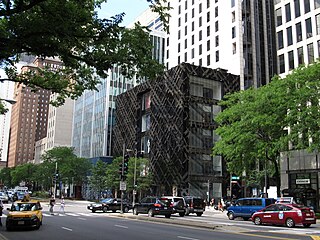
Michigan Avenue is a north-south street in Chicago that runs at 100 east on the Chicago grid. The northern end of the street is at DuSable Lake Shore Drive on the shore of Lake Michigan in the Gold Coast Historic District. The street's southern terminus is at Sibley Boulevard in the southern suburb of Dolton, but like many other Chicago streets, it exists in several disjointed segments.
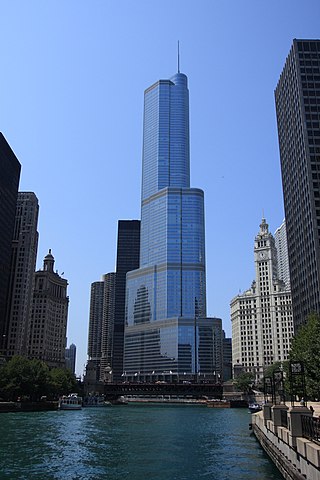
The Trump International Hotel and Tower is a skyscraper condo-hotel in downtown Chicago, Illinois. The building, named for Donald Trump, was designed by architect Adrian Smith of Skidmore, Owings and Merrill. Bovis Lend Lease built the 100-story structure, which reaches a height of 1,388 feet (423.2 m) including its spire, its roof topping out at 1,171 feet (357 m). It is next to the main branch of the Chicago River, with a view of the entry to Lake Michigan beyond a series of bridges over the river. The building received publicity when the winner of the first season of The Apprentice reality television show, Bill Rancic, chose to manage the construction of the tower over managing a Rancho Palos Verdes–based Trump National Golf Course & Resort in the Los Angeles metro area.

The Near North Side is the eighth of Chicago's 77 community areas. It is the northernmost of the three areas that constitute central Chicago, the others being the Loop and the Near South Side. The community area is located north and east of the Chicago River. To its east is Lake Michigan, and its northern boundary is the early 19th-century city limit of Chicago, North Avenue. In 2020 the Near North Side had 105,481 residents, surpassing Lake View as the largest Chicago community area by population. It is also the most densely populated community area and has the second most skyscrapers, after the Loop. With the exception of areas near Goose Island in the northwest, the Near North Side is known for its affluence, typified by the Gold Coast, Magnificent Mile, Navy Pier, and residential skyscrapers.

Downtown Chicago, Illinois, has some double-decked and a few triple-decked streets immediately north and south of the Main Branch and immediately east of the South Branch of the Chicago River. The most famous and longest of these is Wacker Drive, which replaced the South Water Street Market upon its 1926 completion. The resulting bi-level street has an upper-level riverfront boulevard, a lower-level roadway for commercial and through traffic, and a recreational walkway at water level.
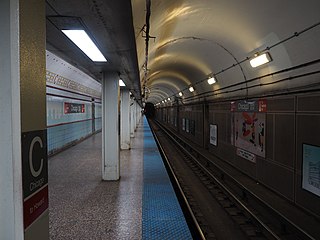
Chicago, is an "L" station on the CTA's Red Line. It serves a significant portion of the Near North Side and Streeterville neighborhoods. With over 5.25 million overall boardings in 2014, it is the busiest station on the Red Line north of the Loop.
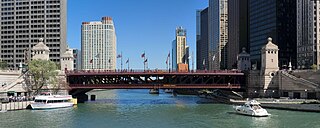
The DuSable Bridge is a bascule bridge that carries Michigan Avenue across the main stem of the Chicago River in downtown Chicago, Illinois, United States. The bridge was proposed in the early 20th century as part of a plan to link Grant Park (downtown) and Lincoln Park (uptown) with a grand boulevard. Construction of the bridge started in 1918, it opened to traffic in 1920, and decorative work was completed in 1928. The bridge provides passage for vehicles and pedestrians on two levels. An example of a fixed trunnion bascule bridge, it may be raised to allow tall ships and boats to pass underneath. The bridge is included in the Michigan–Wacker Historic District and has been designated as a Chicago Landmark.
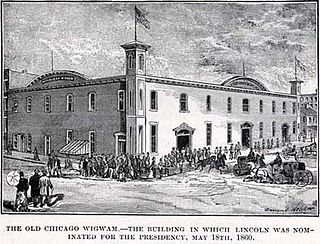
The Wigwam was a convention center and meeting hall that served as the site of the 1860 Republican National Convention. It was located in Chicago, Illinois, at Lake Street and Market near where the Chicago River divides into its north and south branches, on property owned by Garrett Theological Seminary. This site had previously been the site of the Sauganash Hotel, Chicago's first hotel. This is where supporters ushered Abraham Lincoln to the party nomination and the eventual U.S. Presidency. The location at Lake and Wacker was designated a Chicago Landmark on November 6, 2002. The name "Wigwam" was later associated with host locations for both the 1864 Democratic National Convention and the 1892 Democratic National Convention in Chicago.

Sauganash Hotel was a hotel regarded as the first hotel in Chicago, Illinois. Built in 1831, the hotel was located at Wolf Point in the present-day Loop community area at the intersection of the north, south and main branches of the Chicago River. The location at West Lake Street and North Wacker Drive was designated a Chicago Landmark on November 6, 2002. The hotel changed proprietors often in its twenty-year existence and briefly served as Chicago's first theater. It was named after Sauganash, an interpreter in the British Indian Department.

Rush Street is a one-way street in the Near North Side community area of Chicago in Cook County, Illinois, United States. The street, which starts at the Chicago River between Wabash and North Michigan Avenues, runs directly north until it slants on a diagonal as it crosses Chicago Avenue then it continues to Cedar and State Streets, making it slightly less than a mile long. One lane also runs southbound from Ohio Street (600N) to Kinzie Street (400N) as part of a two-way street segment. It runs parallel to and one block west of the Magnificent Mile on the two-way traffic North Michigan Avenue, which runs at 100 east up to 950 north. The street, which is also one block east of the one-way southbound Wabash Avenue, formerly ran slightly further south to the Chicago River where over time various bridges connected it to the Loop, Chicago's central business district.

The Chicago and North Western Railway's Kinzie Street railroad bridge is a single leaf bascule bridge across the north branch of the Chicago River in downtown Chicago, Illinois. At the time of its opening in 1908 it was the world's longest and heaviest bascule bridge. The previous bridges on the same site included a pedestrian span that was the first bridge across the Chicago River; a second bridge that served as Chicago's first railroad bridge; and a third bridge that was one of the first all-steel spans in the United States.

The Michigan–Wacker Historic District is a National Register of Historic Places District that includes parts of the Chicago Loop and Near North Side community areas in Chicago, Illinois, United States. The district is known for the Chicago River, two bridges that cross it, and eleven high rise and skyscraper buildings erected in the 1920s. Among the contributing properties are the following Chicago Landmark structures:

350 North Orleans is the official name of the 24-floor multipurpose building located in the River North community area of Chicago, at the intersection of the North Branch and the Main Branch of the Chicago River. It was designed by Skidmore, Owings & Merrill. In 1988, Helmut Jahn designed an enclosed pedestrian walking bridge over Orleans Street connecting the building to Merchandise Mart. Originally built to serve as the world's largest wholesale buying center for the clothing industry, the building has more commonly known by several other names including River North Point, TheApparel Mart, and the Chicago Apparel Center. The building opened on November 6, 1976.

The Chicago Riverwalk is a multi-use public open space located on the south bank of the main branch of the Chicago River in Chicago, extending from Lake Michigan and the Outer Drive Bridge westward to the Wolf Point area and Lake Street. The Chicago Riverwalk contains restaurants, bars, cafes, small parks, boat and kayak rentals, a Vietnam War memorial, and other amenities.

Salesforce Tower Chicago is a skyscraper at Wolf Point in downtown Chicago. It is the tallest and last built of a three tower megadevelopment partly owned by the Kennedy family. The 835 ft (255 m)-tall tower was designed by Pelli Clarke and was completed in 2023. It is the regional headquarters of software company Salesforce.
Wolf Point East Tower is the second tallest of three buildings being developed in the Near North Side community area on the Wolf Point property at a fork in the Chicago River in downtown Chicago. The building is planned to be approximately 60 stories and 660 feet (201.2 m) tall. It will have 698 units. Although originally intended to be a mixed use building when planned in 2012 and approved in 2013, the building was reenvisioned as an apartment building in 2016. Construction began in 2017 and is currently finished.








